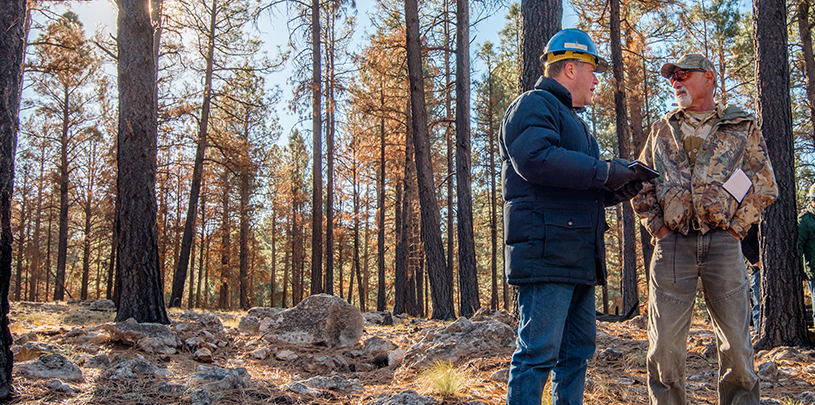
 by Ed Grumbine, Lands Director
by Ed Grumbine, Lands Director
Steve Rosenstock, the Wildlife Habitat Enhancement Initiatives Coordinator for the Arizona Game and Fish Department, has a small budget and shoulders a lot of responsibility to improve habitat across the state. The money comes from the sale of big game tags to Arizona hunters, as well as state taxes on firearms and ammunition. Steve’s responsibilities are a bit more complex to untangle, but they point to why he is such a solid partner for the Grand Canyon Trust to work with on several projects.
I have seen Steve in action on the North Rim Ranches, and I have depended on him at times to help find common ground on tough issues. Recently, we’ve been coordinating mule deer habitat improvement as part of the Trust-sponsored cheat grass control experiments on the west side of the Kaibab Plateau.
“I am the bureaucrat for wildlife improvement work in Arizona,” Steve declares, but this statement only reveals his sense of humor, not his underlying attitude toward his job. In fact, whether he is helping craft research priorities for the 830,000-acre North Rim Ranches, collaborating with us on the Four Forests Restoration Initiative, or sustaining multiple wildlife projects in nearly every nook and cranny of the Arizona Strip, Steve is committed to less paper pushing and more the on-the-ground action to benefit wild animals and wild places. But he uses his considerable knowledge of red tape, rules, and regulations in service of habitat health for pronghorn, elk, and mule deer, as well as the tiny invertebrates that populate spring-fed pools in Arizona’s predominantly arid lands.
It’s unusual to work with a manager who appreciates the links between small and large animals, who grasps the big picture habitat needs of springs-dependent salamanders as well as wide-ranging, thousand-pound elk.
It all started in the 1980s when Steve was an undergraduate on a summer field trip with a biology class from Colorado State. The class explored the Kaibab Plateau, and Steve fell in love: “I saw the Kaibab for what it is—one of the last, best ‘big opens’.”
‘Big open’ to Steve stands for a large landscape relatively protected from large towns and paved roads, and not logged off, played out, or overused by hordes of hikers and hunters. The Kaibab became “iconic for me, personally and professionally,” and this special place led Steve to his 25-year career (and counting) with the state.
Protecting the ecological integrity of large landscapes requires two foundational skills — one based in biology, and the other informed by an appreciation of how people work (or don’t work) together.
Steve gained the biological skills of creating healthy habitats for animals by going to graduate school and paying attention to conditions on the ground once he became a professional wildlife manager. Across ‘big open’ lands, mule deer need to flow from winter to summer range and back again, unimpeded by human developments. Pronghorn must be able to negotiate barbed wire as they kneel to pass underneath fences, and springs-dependent animals must not have their waters sucked dry by other uses. It is difficult enough to manage lands for animals in a state where the human population has almost doubled over the years that Steve has been doing his job. And this leads to the second necessary skill.
Steve’s success at maintaining healthy habitats for animals depends on the realization that “in this new era of conservation, we don’t manage wildlife, we manage people.”
And managing people requires collaboration:
We are not just resource agencies writing and carrying out management plans. We have to work with partners to get the job done. If we are going to be successful, there is no alternative to collaboration.
That is why Steve works with so many partners — federal and state agencies, hunters and fishers, local politicians and various environmental groups, including the Grand Canyon Trust.
In this new era where wildlife populations and habitat health depend on collaboration, how do you craft abiding conservation legacies for people and nature? Across large landscapes like the North Rim Ranches, where many people hold strong opinions, there is no such thing as an ‘easy’ answer to this question. But there are people like Steve who are skilled at the give and take of working together and recognize that “collaboration forces people to expand their decision space for the benefit of all.” That is the kind of partner that you want to work with.
It all goes back to the Kaibab Plateau, that ‘big open’ that propelled a young manager toward a career working on behalf of animals and the land. And after 25 years, Steve says he is “still learning how to do my job, still working to get collaboration right, and just now beginning to see the fruits of partnerships on the ground.”
As 2024 draws to a close, we look back at five maps we created this year that give us hope for 2025.
Read MoreA small victory in the legal case challenging Daneros uranium mine, near Bears Ears National Monument.
Read MoreMugs, handmade soaps, high fashion, jewelry and more. There's something for everyone on your holiday shopping list.
Read More